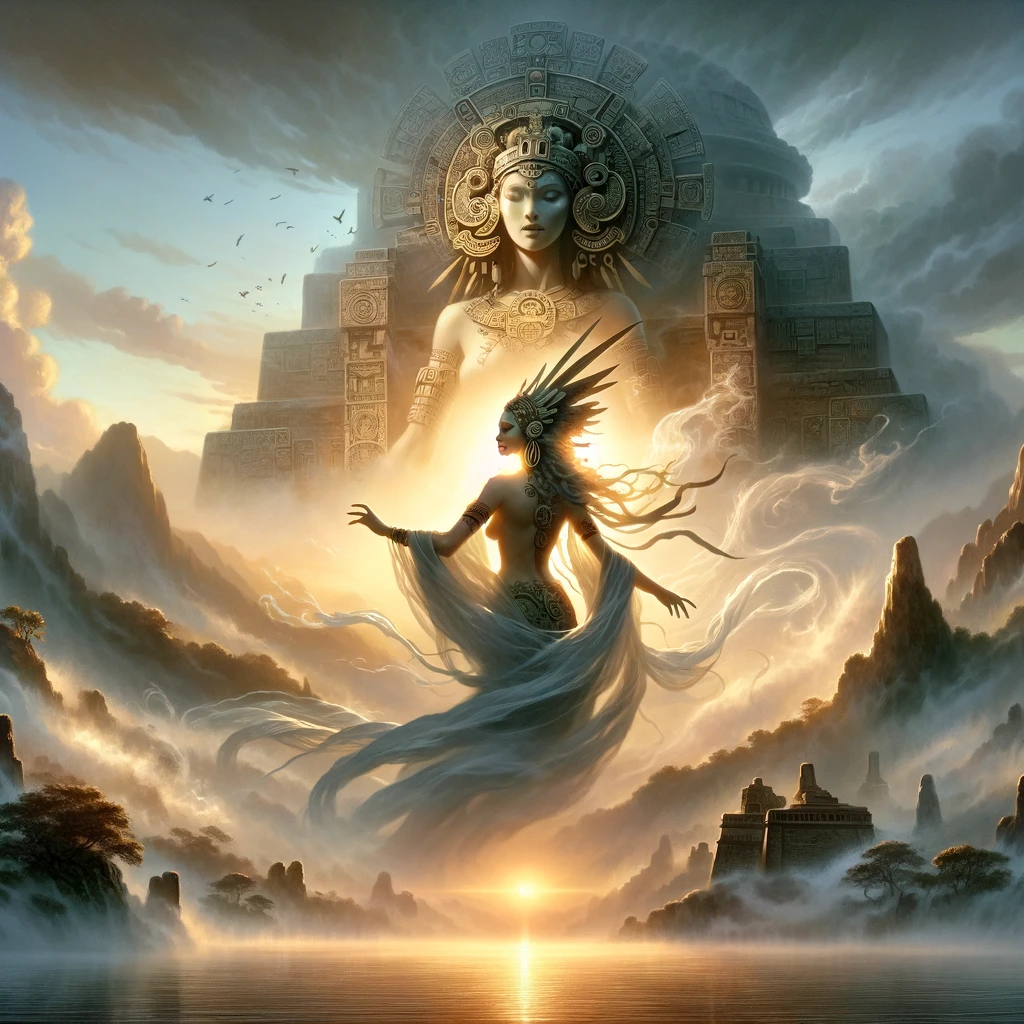
In the rich tapestry of Aztec mythology, each deity carries a unique essence, intertwining natural elements, human emotions, and cosmic duties. Among these divine beings, Ayauhteotl (pronounced ay-ow-TEH-otl) emerges as a fascinating figure, embodying the ephemeral qualities of fog and the radiant allure of glory. This article delves into the enigmatic realm of Ayauhteotl, exploring her significance, symbolism, and the role she played in the spiritual life of the Aztec civilization.
The Essence of Ayauhteotl
Ayauhteotl, whose name translates to "the essence of the mist," is a lesser-known deity within the Aztec pantheon. She is often depicted as a mysterious force, shrouded in the early morning fog that rolls over the lakes and valleys of the Aztec empire. This mist, both concealing and revealing the world at dawn, symbolizes the dual nature of Ayauhteotl—she is a harbinger of clarity and obscurity, guiding the Aztecs through the metaphorical mists of life.
Symbolism and Representation
In Aztec iconography, Ayauhteotl is seldom portrayed directly; her presence is implied through symbols of fog, light diffusing through mist, and sometimes through depictions of warriors adorned in her honors. The imagery associated with her encapsulates the fleeting moments of glory and the veiled secrets of the universe. As the deity of haze, she is linked to the idea of hidden knowledge and the unseen truths lying just beyond human perception.
The Dual Role in Aztec Society
Ayauhteotl's influence extends beyond the mystical realm, playing a pivotal role in the social and ceremonial life of the Aztec people. She is associated with the concept of fame and glory, especially in the context of warfare and the bravery of warriors. Aztec warriors believed that by demonstrating valor and achieving great deeds on the battlefield, they could capture the fleeting attention of Ayauhteotl, thus ensuring their names and actions would be remembered and celebrated.
Ceremonies and Worship
Though specific rituals dedicated solely to Ayauhteotl are not extensively documented, it is believed that ceremonies invoking her presence were intertwined with appeals for protection, guidance through uncertainty, and the granting of glory to deserving warriors. Incense, prayers, and offerings might have been made at dawn, as the mist settled over the land, in an attempt to commune with her essence and seek her favor.
The Philosophical Aspect
The worship of Ayauhteotl also reflects a deeper philosophical engagement with the concepts of impermanence and the ephemeral nature of life. The Aztecs, profoundly aware of the fleeting moments of existence, saw in Ayauhteotl a divine manifestation of this transient reality. Through her, they were reminded of the importance of seizing the moment, striving for greatness, and the inevitable fading of glory into the mists of time.
Conclusion
Ayauhteotl, the Aztec deity of haze and glory, serves as a reminder of the complexities of existence—where visibility and obscurity, triumph and oblivion, are perpetually intertwined. Her presence in Aztec mythology invites contemplation on the transient yet impactful nature of human endeavors. As we peel back the layers of mist that shroud her legacy, Ayauhteotl emerges not just as a deity of the past but as a timeless symbol of the pursuit of meaning amidst the impermanence of life.
The Essence of Ayauhteotl
Ayauhteotl, whose name translates to "the essence of the mist," is a lesser-known deity within the Aztec pantheon. She is often depicted as a mysterious force, shrouded in the early morning fog that rolls over the lakes and valleys of the Aztec empire. This mist, both concealing and revealing the world at dawn, symbolizes the dual nature of Ayauhteotl—she is a harbinger of clarity and obscurity, guiding the Aztecs through the metaphorical mists of life.
Symbolism and Representation
In Aztec iconography, Ayauhteotl is seldom portrayed directly; her presence is implied through symbols of fog, light diffusing through mist, and sometimes through depictions of warriors adorned in her honors. The imagery associated with her encapsulates the fleeting moments of glory and the veiled secrets of the universe. As the deity of haze, she is linked to the idea of hidden knowledge and the unseen truths lying just beyond human perception.
The Dual Role in Aztec Society
Ayauhteotl's influence extends beyond the mystical realm, playing a pivotal role in the social and ceremonial life of the Aztec people. She is associated with the concept of fame and glory, especially in the context of warfare and the bravery of warriors. Aztec warriors believed that by demonstrating valor and achieving great deeds on the battlefield, they could capture the fleeting attention of Ayauhteotl, thus ensuring their names and actions would be remembered and celebrated.
Ceremonies and Worship
Though specific rituals dedicated solely to Ayauhteotl are not extensively documented, it is believed that ceremonies invoking her presence were intertwined with appeals for protection, guidance through uncertainty, and the granting of glory to deserving warriors. Incense, prayers, and offerings might have been made at dawn, as the mist settled over the land, in an attempt to commune with her essence and seek her favor.
The Philosophical Aspect
The worship of Ayauhteotl also reflects a deeper philosophical engagement with the concepts of impermanence and the ephemeral nature of life. The Aztecs, profoundly aware of the fleeting moments of existence, saw in Ayauhteotl a divine manifestation of this transient reality. Through her, they were reminded of the importance of seizing the moment, striving for greatness, and the inevitable fading of glory into the mists of time.
Conclusion
Ayauhteotl, the Aztec deity of haze and glory, serves as a reminder of the complexities of existence—where visibility and obscurity, triumph and oblivion, are perpetually intertwined. Her presence in Aztec mythology invites contemplation on the transient yet impactful nature of human endeavors. As we peel back the layers of mist that shroud her legacy, Ayauhteotl emerges not just as a deity of the past but as a timeless symbol of the pursuit of meaning amidst the impermanence of life.